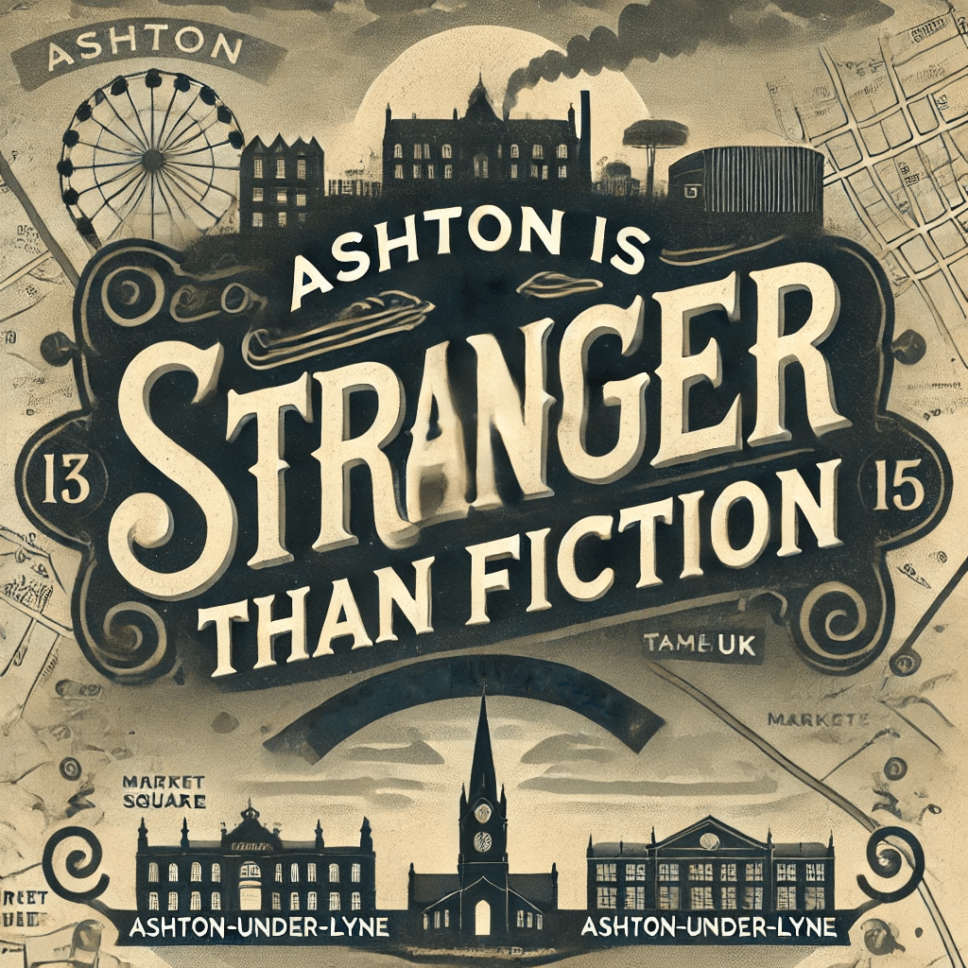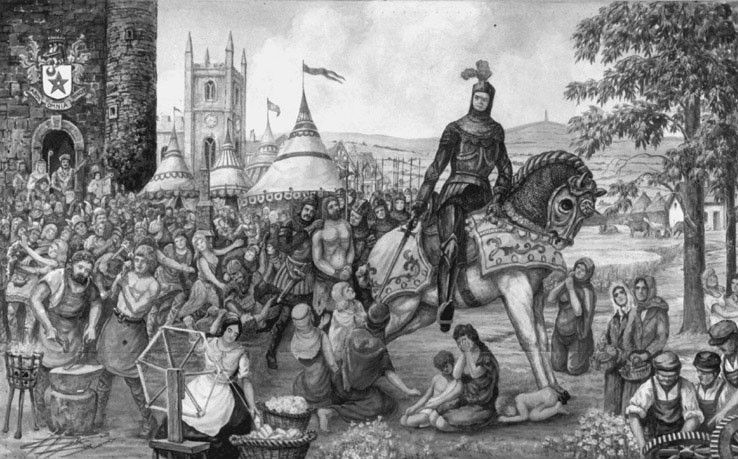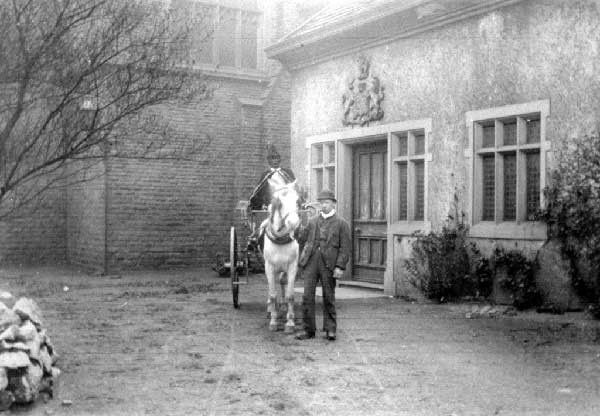Ashton is Stranger Than Fiction – The Black Knight of Ashton

This latest Ashton is Stranger than Fiction post covers The Black Knight of Ashton, Sir Ralph De Assheton was by all accounts a man feared across the lands of Ashton-under-Lyne and England; but history may have also been somewhat unkind to someone who was also a brave commander and loyal to his King. A loyalty that ultimately may have cost him his life. If the records available are correct Sir Ralph was born in 1422 at Ashton Old Hall, his father was Sir John De Assheton and his mother was Sir John’s second wife Margaret Byron. Sir Ralph had a half-brother, Sir Thomas De Assheton, Alchemist to King Edward IV.
Although we don’t have any documentary evidence to support this, we must assume that Sir Ralph’s becoming Page of Honour to Edward IV was due to his Brother’s position at court as a Knight of Lancashire. The position of Page of Honour is normally awarded to a male at the age of 13, and the title still exists today although the daily duties associated with it are no longer part of the role. A page of Honour was chosen from the houses of the nobility and attended all state occasions with the Monarch; being chosen for this role bestowed honour on the families involved.
It is not clear when his role as Page of Honour ended, but it is clear he married at a young age. In 1439, he married Margaret Barton of Middleton Hall and further research uncovered they were betrothed the year before. This at the death of Margaret’s father Sir John De Barton meant the Middleton Estate passed into the Assheton family; this remained so until 31st December 1765 when another Ralph De Assheton passed away.
Sir Ralph De Assheton’s fearsome reputation grew according to history locally and nationally. It was reported locally that each Monday after Easter he rode through his lands around Ashton Old Hall ensuring that all signs of winter were no longer visible. History seems to suggest he despised the sight of Corn Marigolds and if any were found on his lands during these forays; judgment on those responsible was swift. Any of his tenants responsible for this heinous crime were placed in Barrels with nails driven through them. They were then rolled down the local hills to their deaths as an example to others. This reputed behaviour and his time as Vice-Constable of England earned him the title of the Black Knight of Ashton.
 Throughout his eventful life, Sir Ralph De Assheton held many positions of honour, he was High Sherriff of York from 1471 to 1473, appointed by his commander the Duke of Gloucester. On the 24th of July 1482, he became a Knight Banneret and was Knighted by Richard III of the House of York. Following this in 1483 Sir Ralph was appointed Vice-Constable of England and Lieutenant of the Tower of London; he played a significant role in defending London from the first rebellion against King Richard III. So, although Sir Ralph De Assheton had a cruel reputation; he may not have been the man portrayed by the people of Ashton under Lyne for so many centuries. His crime may have been his loyalty to the man reputedly responsible for the deaths of the Princes in the Tower.
Throughout his eventful life, Sir Ralph De Assheton held many positions of honour, he was High Sherriff of York from 1471 to 1473, appointed by his commander the Duke of Gloucester. On the 24th of July 1482, he became a Knight Banneret and was Knighted by Richard III of the House of York. Following this in 1483 Sir Ralph was appointed Vice-Constable of England and Lieutenant of the Tower of London; he played a significant role in defending London from the first rebellion against King Richard III. So, although Sir Ralph De Assheton had a cruel reputation; he may not have been the man portrayed by the people of Ashton under Lyne for so many centuries. His crime may have been his loyalty to the man reputedly responsible for the deaths of the Princes in the Tower.
In the second rebellion by the House of Tudor against the rule of Richard III and the House of York, Sir Ralph De Assheton fought at the Battle of Bosworth Field. On this day in history, the House of York fell as Richard died following a charge on Henry Tudor’s position. The charge failed and Richard was slain by the troops commanded by Sir William Stanley. The followers of Richard III were hunted down after the Battle of Bosworth Field and it is reported that Sir Ralph De Assheton was not killed until the following year. History records he was murdered on the first Monday after Easter 1486, April 5th being the date. His reputation was clearly in question as he was seen as a traitor to the House of Lancaster, and many locally would have been loyal to this cause.
What is very clear from history is the fact that following the death of his King, Richard III, he was never pardoned for his loyalty to the House of York. Further research suggests a general pardon for Sir Ralph’s family was issued by Henry VII in 1487 to his son Sir Richard De Assheton of Middleton Hall. Sir Richard did not become a Knight until 1497 under King Henry VII but it was Sir Ralph De Assheton’s grandson, Sir Richard De Assheton that secured the family’s position for generations.
A brave knight like his Father and Grandfather, he led the Middleton Archers against the armies of James IV of Scotland at the Battle of Flodden. On that day, Thomas Howard Duke of Norfolk was the victor, 10,000 Scots were killed including the last King in history to lead his army into battle, James IV. The Battle of Flodden took place in Northumbria and was a stand against an invading Scottish army in 1513; a memorial to the Middleton Archers still exists in St Leonards Church Middleton and is thought to be the oldest War Memorial in the world.
I can only conclude after reading so much about the De Assheton family  that they were men of honour in a cruel time. Sir Ralph De Assheton had a reputation for cruelty in his birthplace of Ashton, but oddly such events were not recorded in the history of Middleton Hall, and you would have to assume that if he despised Corn Marigolds in Ashton the same would apply in Middleton. As history does not record this, it must then draw into question the truth about the man. Was it the case that his family and community in Ashton under Lyne were, in fact, loyal to Edward IV and later Henry VII? Sir Ralph’s Brother Sir Thomas De Assheton died in 1460, his son Sir John De Assheton was we must assume Lord of the Manor in Ashton long after the death of his uncle. Ashton Old Hall remained the seat of the Assheton family until the early 16th Century when the family due to marriage moved to Dunham Massey.
that they were men of honour in a cruel time. Sir Ralph De Assheton had a reputation for cruelty in his birthplace of Ashton, but oddly such events were not recorded in the history of Middleton Hall, and you would have to assume that if he despised Corn Marigolds in Ashton the same would apply in Middleton. As history does not record this, it must then draw into question the truth about the man. Was it the case that his family and community in Ashton under Lyne were, in fact, loyal to Edward IV and later Henry VII? Sir Ralph’s Brother Sir Thomas De Assheton died in 1460, his son Sir John De Assheton was we must assume Lord of the Manor in Ashton long after the death of his uncle. Ashton Old Hall remained the seat of the Assheton family until the early 16th Century when the family due to marriage moved to Dunham Massey.
Was the Black Knight then in fact as black as he was painted by the people of Ashton, he was honoured for his bravery in battle and feared as Vice-Constable of England and Lieutenant of the Tower of London? The following poem is associated with Sir Ralph:
Sweet Jesu, for thy mercy’s sake and for thy bitter passion. Save us from the axe of the tower and from Ralph of Ashton
The Riding of the Black Lad also known as the Black Knight Pageant celebrated the death of Sir Ralph De Assheton the tyrant and history suggests he was killed by a member of his own family. The truth is possibly a great deal more complicated than this and he was more than likely killed for his loyalty to Richard III. This could have been done by a member of his family as their loyalties were to Edward IV and the Princes in the Tower. But equally, the agents of Henry VII could have been responsible for his death as many of those loyal to Richard III were hunted and killed following the Battle of Bosworth. We will probably never know the whole story, but somewhere in an unread archive or document the truth is waiting to be discovered; on the story of the Black Knight Sir Ralph De Assheton.
Register For An Account
Save & manage your details, access invoices, and enjoy a quicker shopping experience!